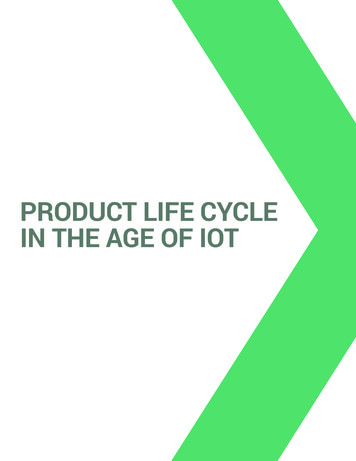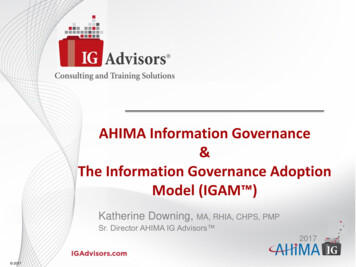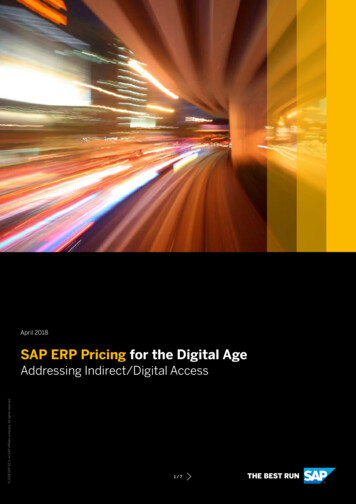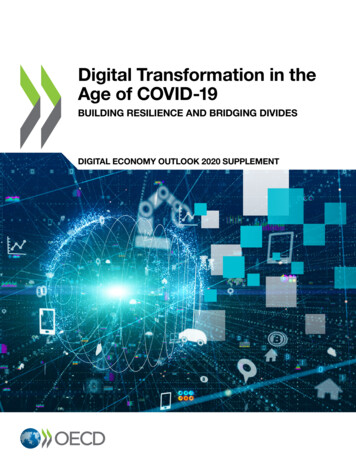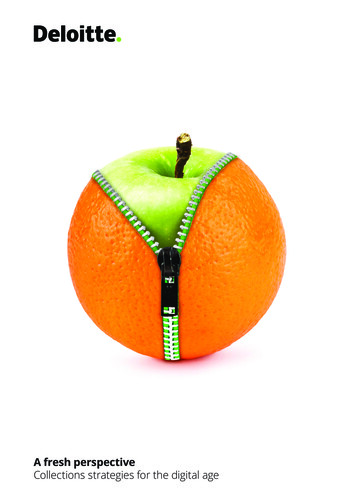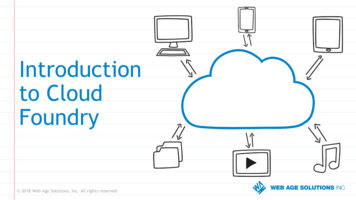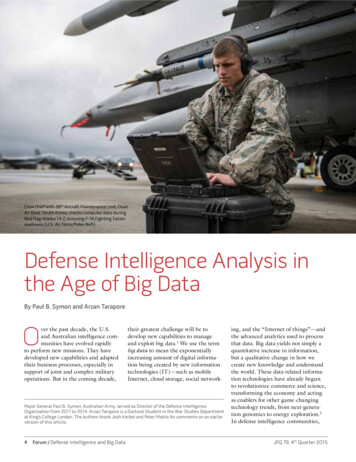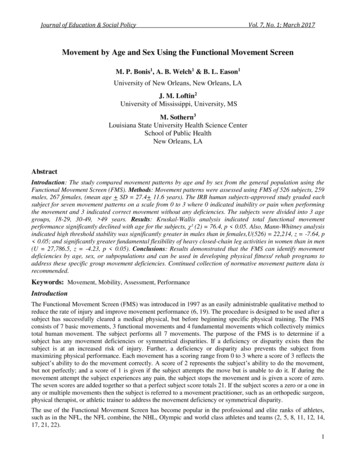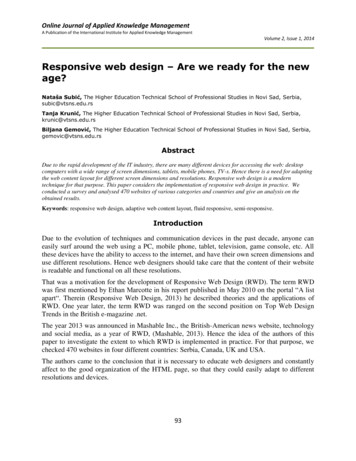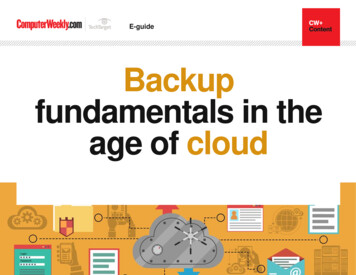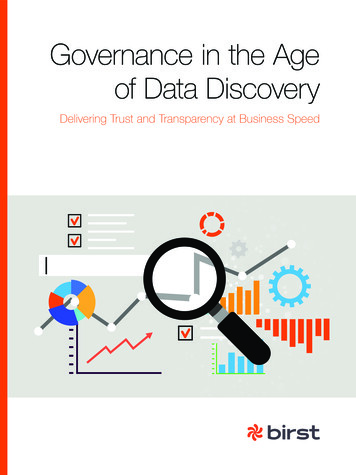
Transcription
Governance in the Ageof Data DiscoveryDelivering Trust and Transparency at Business Speed
Governance in the Age of Data Discovery: Delivering Trust and Transparency at Business Speed 2CONTENTSGOVERNANCE VERSUS AGILITY:THE CONTINUED EVOLUTION OF BUSINESS INTELLIGENCE 3“IMPERFECT BUT FAST”ANALYTICAL SILOS DELIVER SPEED, BUT AT A PRICE5TODAY’S REALITY: A NEED FOR CENTRALIZEDAND DECENTRALIZED GOVERNANCE 7THE END GOAL: TRANSPARENT GOVERNANCE WITHTHE SPEED YOUR BUSINESS REQUIRES 9CONCLUSION 12
Governance in the Age of Data Discovery: Delivering Trust and Transparency at Business Speed 3GOVERNANCE VERSUS AGILITY:THE CONTINUED EVOLUTION OF BUSINESSINTELLIGENCEBI Evolution TradeoffThe business intelligence market is undergoing another major evolution. Historically,the pendulum or climate of the category has traded off between centralizedgovernance of data and the enablement of self-service and agility for the operationallines of business. Today, the industry faces another crossroads in this evolutionwith the continued adoption of data discovery and contemporary end-user centricAGILITYGOVERNANCEvisualization products.In the 1990’s, tools such as Crystal Reports were the first platforms beyond MicrosoftExcel to deliver higher levels of reporting autonomy to the business by enabling amoderately sophisticated Windows desktop user to create and manipulate keyreports and distribute them across a team of business users. In the late 1990’s,the proliferation of such reporting tools experienced aggressive growth. While theyenabled a new level of line of business data analysis, they often resulted in siloed andinconsistent views of the state of key metrics and data across different groups ofusers in the organization.In response to this continued proliferation of new tools, corporate IT organizationstook back control over reporting and subsequently, analytics, in order to ensurehigher levels of data consistency and trust. As a result, sophisticated BI platforms byBusinessObjects, Cognos, Microstrategy and Oracle combined with data warehousesand data marts to enable IT organizations to inhibit the growth of ungovernedanalytical business data. While these platforms created a strong ability to govern dataand enable sophisticated BI capabilities, the tradeoff for this ability was a slow andexpensive centralized process.In the mid to late 2000’s, frustrated business users began large-scale adoption ofwhat are now classified as data discovery tools. These tools enabled users to reclaimthe self-service aspect of data analysis at line of business while offering a widerarray of visualization options than those offered by Microsoft Excel. Today, thesedata discovery products have become popular within the lines of business acrossglobal enterprises, just as desktop reporting tools did in previous generations of the BI
Governance in the Age of Data Discovery: Delivering Trust and Transparency at Business Speed 4“[Data discovery vendors’] salesmarketplace. Unfortunately, because these tools lack the architecture needed to ensurestrategy has been hugely successful,enterprise-wide data governance, their popularity has resulted in the proliferation ofanalytical silos creating what analyst Wayne Eckerson calls a “spreadmart effect” thatespecially in organizationswithout strong BI/IT standards fortools and data, and evenin some with published standardswhere business users havehigh dissatisfaction with incumbenttools, processes, and data.”-- Eckerson Groupundermines trust in the data.1 As a result, the need for organizations to refocus ondata governance has re-emerged. Enterprise business leaders demand that a newbalance of data management must be established. The new model must promise notonly governance, but also the ability to easily source, share and manage data acrossdifferent departments and lines of business with agility.While legacy BI platforms afford analytical strength and governance, these platformsfail to fulfill the needs of today’s ‘discovery-centric’ users. Heavyweight architectures,high expense loads and sluggish data delivery speeds cripple the ability of legacyplatforms to deliver punctual business intelligence at the breakneck speed of themodern business landscape.1Wayne Eckerson, Making Peace with Tableau (The New BI Leader, Aug 2015)
Governance in the Age of Data Discovery: Delivering Trust and Transparency at Business Speed 5“IMPERFECT BUT FAST”ANALYTICAL SILOS DELIVER SPEED, BUT AT A PRICEDisillusioned by the ineptitude of legacy BI, business users have resorted todata discovery technologies. While data discovery tools provide speedy datamanipulation functionality, these tools create analytical silos that hinder the abilityto make decisions with confidence. Business users have come to accept datainconsistency as the price to pay in order analyze data without depending on acentral BI team. As such, they have adopted the maxim “imperfect but fast is betterthan perfect but slow”.“BI has overestimated the need for a single version of the truth for decades,” saysanalyst Boris Evelson. “If it costs far more to get a single version of the truth, maybeit’s wiser to take a cheaper version which is 80 percent good.” 2In an attempt to propagate this view, many data discovery suppliers downplaythe importance of a unified view of a business. They state that the proverbial“single version of the truth” is a myth and not indicative of the realities of today’sbusiness climate.“Through 2016, only 10% ofBut the reality is that much of the backlash against the idea of a “singleself-service business intelligenceversion of the truth” is due to the massive effort required to deliver it usinginitiatives will be sufficiently well-traditional legacy approaches. This backlash is further exacerbated by thegoverned to prevent inconsistenciesshortcomings of popular contemporary discovery products. The daunting taskthat adversely affect the business.”of manually delivering a truly governed layer of data includes a comprehensive—Gartner, Embrace Self-Serviceunderstanding of core business logic, the ability to build and test integrated dataData Preparation Tools for Agility, butGovern to Avoid Data Chaos,models, tools for performing extraction, transformation and loading (ETL) routinesCindi Howson, 17 March 2015across corporate systems, channels for proliferating enterprise-wide meta data anda demand for governance-centric business procedures.The acceptance of inconsistent data in favor of agility is rooted in pragmatism, not in arejection to better governance. Despite having a deep understanding of the perceivedlevel of effort using traditional means, analysts agree that the need for governed andtrusted data remains a key issue for today’s CIOs that manage analytically drivenorganizations:2Drew Robb, Getting Good BI Without a Single Version of the Truth (Enterprise Apps Today, Aug 2015)
Governance in the Age of Data Discovery: Delivering Trust and Transparency at Business Speed 6 “Lack of trust is one of the greatest, and mostly unspoken, barriers to successin business intelligence programs.” -- Howard Dresner, Dresner Advisory Services 3 “Without appropriate processes and governance, self-service capabilities canintroduce multiple versions of the truth, increase errors in reporting andleave companies exposed to inconsistent information, creating a challengefor BI leaders.” — Cindi Howson, Gartner Research4 Desktop visualization tools, left unchecked, result in “ungoverned spreadmartsthat increase your support costs, undermine data consistency and waste yourstaff’s time reconciling reports.” -- Wayne Eckerson, Eckerson Group 534Howard Dresner, Dresner’s Point: In Business Intelligence, Trust is an Elephant in the Room (SandHill Business Strategy, May 2015)Cindi Howson, Embrace Self-Service data Preparation Tools for Agility, but Govern to Avoid Data Chaos (March 2015 Gartner.com)5ibid pg 4
Governance in the Age of Data Discovery: Delivering Trust and Transparency at Business Speed 7TODAY’S REALITY: A NEED FOR CENTRALIZEDAND DECENTRALIZED GOVERNANCEIn today’s business environment, ensuring BI and analytic success requiresacknowledging that some scenarios are more tolerable of imperfect data thanothers, or don’t require a full view of the business. IT and business leadersmust recognize that the level and ownership of governance depends on the scopeof the use case and reach of data required required to perform the analysis athand. This means enabling centralized (top-down) and decentralized (bottom-up)governance.For example, it would be impractical for a marketing analyst who needs to quicklyunderstand which campaigns are generating the greatest number of leads tospend time and energy on governance when all the data needed is available fromthe marketing automation system. In this scenario, a local, bottom-up view of “thetruth” is enough for him to make informed and on-demand decisions, and to thenshare such insights with users in the same lines of business.However, for cross-operational corporate-level business performance metrics,people will seek a broader, more complete understanding of the business and the“Organizations that view data as‘truth’ with common rules andsemantics are about 10 times aslikely to claim complete BI successas organizations with multipleinconsistent sources.”– Dresner Advisory Servicesability to work with trusted, consistent data becomes critical.For instance, lead-to-cash analysis requires data from three different departments(Marketing, Sales, and Finance) and three separate systems (marketing automation,CRM, ERP). In this scenario, a consistent and reliable view of the informationbetween departments and systems – one that provides a common definition of“Lead” or “Revenue”, for example – is necessary to avoid confusion and conflictingdecisions.In a 2015 study of the global BI market, Dresner Advisory Services found apowerful and direct correlation between success with business intelligence and anorganization’s state of data (fig. 1, below):
Governance in the Age of Data Discovery: Delivering Trust and Transparency at Business Speed 8Data Governance DefinedIt’s important to understand thatdata governance isn’t only abouttechnology. One cannot purchasegood governance with the choiceof a particular BI software solution.Data governance is a framework thatconsists of organizational structuresand processes to manage theusability, integrity and security ofenterprise data. Per Howard Dresnerof Dresner Advisory Services, it isa set of “processes and roles ofthat include standards, policies andprocedures for steering, organizing,implementing and executing BIinitiatives.” 6 Organizations thathave implemented successfulgovernance practices understandthat this is a continuous processthat should be owned by bothbusiness and IT leaders. That said,not every BI solution in the market isequally capable of supporting goodgovernance. When evaluating BIproviders, it’s helpful to understandwhich capabilities are offered byeach product to deliver trustedand consistent data across theorganization.“Respondents that say their organization views data as ‘truth’ with commonrules and semantics are about 10 times as likely to claim complete BI success asorganizations with multiple inconsistent sources. Even organizations with consistentdata at departmental levels are somewhat or completely unsuccessful nearly 70percent of the time.”Figure 1 - Source: Dresner Advisory Services, 2015 Wisdom of Crowds BI Market StudyBut good governance isn’t just about making confident decisions. Not only doespoor governance fail to provide trusted data, but it also can compromise regulatorycompliance, privacy and security to a disastrous degree.This is particularly true in the era of Big Data and data lakes, where poor dataquality – inconsistency, redundancy, etc. – is a natural consequence of storingmassive amounts of data without preparation or organization.Analytical silos offer speed and autonomy to analysts working with specific,localized use cases. In order to expand the reach of analytics across theenterprise and support business-critical metrics that touch multiple systems, atrusted and global view of the business is absolutely essential.6Howard Dresner, Dresner Advisory Services Blog, May 30, 2014
Governance in the Age of Data Discovery: Delivering Trust and Transparency at Business Speed 9AGILITYTHE END GOAL: TRANSPARENT GOVERNANCE WITHTHE SPEED YOUR BUSINESS REQUIRESTransparent governance views the choice between agility and governance as afalse dichotomy. The fundamental ideology behind transparent governanceis simple--trusted data does not have to be synonymous with restrictiveaccess and obstinate wait times. By implementing transparent governance,organizations can enable local (decentralized) execution with global (centralized)consistency, reconciling speed with trust at enterprise scale.GOVERNANCECENTRALIZED VS. DECENTRALIZED1An Example of Centralized (top-down) GovernanceJulie is in the office of the CFO to discuss a key product line /P&L center for thecompany. As this is a new product line for the company, it requires a new set ofcalculations across different systems that hold information about inventory levels,ship date, pricing/sales volumes, AR, delivery and logistics for out bounding thesegoods to their distribution partners. In order to ensure compliance with GAAPrevenue and internal revenue recognition policies, Julie must work with IT and thecompany’s internal audit.Once created, the metric “revenue product1234 new” can be published to allof the key global distributions operations. This will ensure that analysis, revenueforecasting and quarterly rollups are done using the same version of revenuethat has been vetted by compliance and audit teams to ensure accuracy andconsistency across their 54 different field operations throughout the globe. Datagovernance is supported, but in a manner that is 100% transparent to key line ofbusiness users.
Governance in the Age of Data Discovery: Delivering Trust and Transparency at Business Speed 102An Example of Decentralized (bottom-up) Governance:Bob the marketing analyst looks at specific campaign performance indeveloped markets in NA and notices that for certain demographics, variousmessages and campaign channels are producing higher than expected resultsand conversions to revenue. Bob mashes together local consumer data from3rd party sources to re-test his hypothesis and defines a new variable, calledSegmentX performance campaigntypeABC.Bob then can publish this new insight and make it available to his peers fortrusted collaboration in other developed territories of business such as the UK,Benelux and ANZ. Since NA is the largest market for the company’s productsby a large margin, he can then “govern” the newly developed campaignperformance metric for the company and promote it to the global level spanninghis region, UK, ANZ and Benelux. Bob was able to do all of this without thehelp or the overhead of an IT interaction. 7According to technology research firm Gartner 7, BI and analytics leaders must: Establish protocols for access to new datasets in order to identify opportunitiesto derive additional value from information assets. Establish and maintain a team approach that delivers ongoing success bybalancing use of skilled resources and development of more localized business skills. Certify and manage key input datasets and govern information outputs to alignorganizational accountability for data discovery with business outcomes,ensure consistent understanding and interpretation, and encourage a datadriven culture. Plan to support and operate live data discovery platforms in a scalable,sustainable and resilient manner, including collaborative processes.7Joao Tapadinhas, Alan D. Duncan, Governance Is Critical for User Empowerment With Data Discovery (July 2015, Gartner.com)
Governance in the Age of Data Discovery: Delivering Trust and Transparency at Business Speed 11Not every BI product available in the market is capable of supporting transparentgovernance. From a technology perspective, delivering a unified view of datawithout sacrificing end-user speed and autonomy begins with modern BI architectures.These are capabilities companies should look for when evaluating BI providers:Reusability: Enablement of users to create their own measures and dimensions,and instantly make them available to all, while complying with defined security rolesand permissions.Navigability: The ability to search and browse data and business terms(metadata) across all analytic content, including: data sets: data sets, visualizations,reports and dashboards.Security: Multiple layers of security — user-, role-, object-, data-level - during discoveryand consumption to ensure the right people have access to the right data.Networked: A network of interwoven virtual BI instances that share a commonanalytical fabric, for seamless sharing of measures and dimensions betweenindividuals and groups.Completeness: Governance and visibility across all data sets, set once, andavailable forever. Reliable data lineage. No dark data.Consistency: A single view of governed measures and dimensions, for users inboth discovery and centralized use cases.Transparency at business speed: Delivered without administrative overhead.
Governance in the Age of Data Discovery: Delivering Trust and Transparency at Business Speed 12CONCLUSIONThe pace of modern business world has increased significantly, and traditional BIplatforms have failed to keep up with evolving analytical requirements. Businessusers demanding speed and autonomy have adopted desktop-based discoveryand visualization products, circumventing corporate BI standards for toolsand data. Unfortunely, while these products deliver speed and ease of use,they lead to the proliferation of analytical silos and decision-making based onunreliable data. Business users, believing they must choose between agilityand governance, seem resigned to accept that self-service comes at the costof imperfect data. However, leading companies know that there is a powerfuland direct correlation between business success and having a trusted viewof enterprise data. Companies evaluating BI solutions must look for modernarchitectures that support transparent governance at business speed and delivera unified view of data without sacrificing end-user autonomy. By implementingtransparent governance, organizations can enable local execution with globalconsistency and reconcile agility with trust at enterprise scale.ABOUT BIRSTBirst is the global leader in Cloud BI and Analytics for the Enterprise. Birst’spatented 2-tier BI and analytics platform enables enterprises to create trusteddata while empowering business users to manipulate the information in a fastand easily accessible manner.Thousands of the most demanding businesses trust Birst to make metricdriven business execution a reality.Every day we help companies make smarter decisions based on data they cantrust. Thousands of the most demanding businesses trust Birst to make metricdriven business execution a reality. Learn more at www.birst.com and join theconversation @birstbi.
data discovery technologies. While data discovery tools provide speedy data manipulation functionality, these tools create analytical silos that hinder the ability to make decisions with confidence. Business users have come to accept data inconsistency as the price to pay in order analyze
